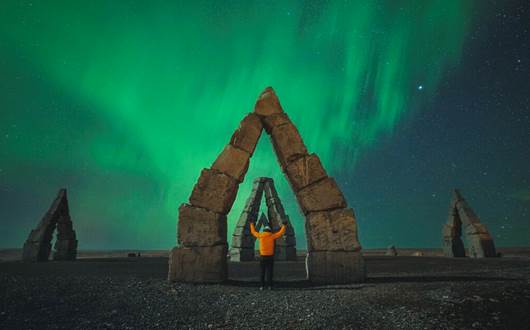
Best Time to Visit Iceland: Top Activities, Weather and Seasons Guide
When is the best time to go to Iceland? Experience the Northern Lights-lit winter, the Midnight Sun-drenched summer, or the landscape-transforming spring and fall.
Route 1 circles Iceland like a thread through a dream—unchanging in shape, but endlessly varied in experience. Some speed through in a day; others linger, drawn to every glacier, fjord, and thundering fall. But what time is the most optimal for a typical traveler in Iceland?
Every Iceland Ring Road itinerary is more of a starting point than a strict plan—it’s flexible and easy to tailor to your preferences. Since Route 1 winds through many of Iceland’s most iconic regions—the South Coast, Eastfjords, Northern Coast, and the open plains of the West—there’s something to discover around nearly every bend. This is the kind of road trip you'll remember forever.
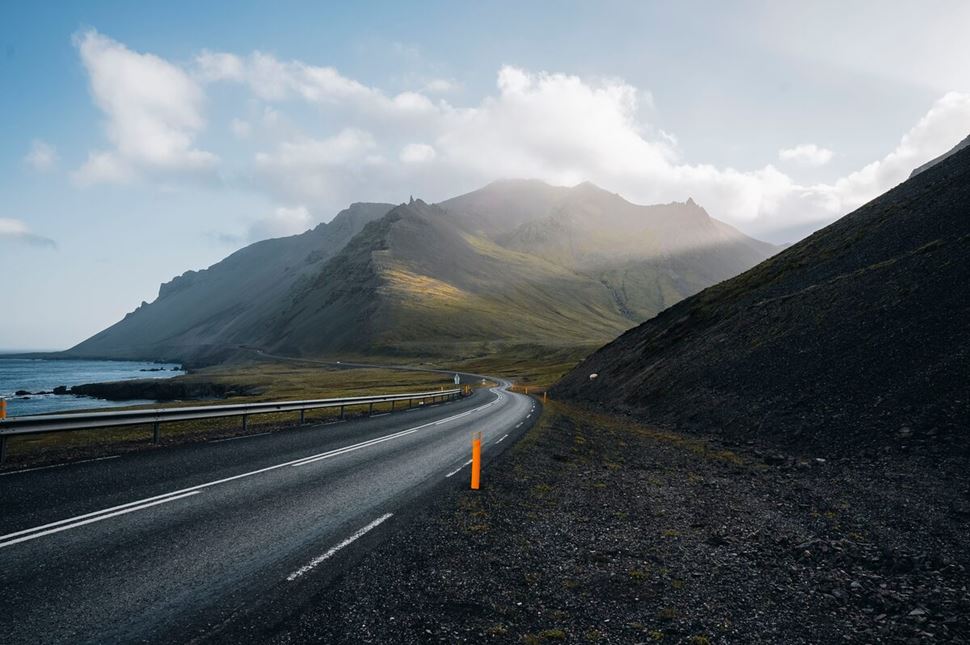
Paved roadway of the Ring Road in the Eastfjords. Picture by Gunnar Gaukur.
Route 1 is Iceland's only loop road, linking the country’s major regions in a single, continuous stretch that circles back to Reykjavík. While the main road is fully paved, many side routes leading into the Highlands transition into gravel. How many kilometers (miles) is the Ring Road in Iceland? Around 1,322 km (821 mi). Beyond its appeal as a scenic route for travelers, it also serves as a vital artery, connecting the capital to distant towns like Akureyri.
Iceland’s circular highway is officially called Road 1—the only route in the country with a single-digit number. Because of this, it’s often referred to as Route 1, Highway 1, or Þjóðvegur 1 in Icelandic. Outside of Iceland, it’s commonly known as the Icelandic Ring Road, since “Ring Road” is a general term used for circular routes, often around cities.
Icelandic Ring Road trip can be completed counterclockwise and clockwise—the driver's choice—with the path marked by plenty of signage. However, attractions are harder to spot, especially when you have to cover long distances every day. To make sure you don’t miss anything worthwhile, use a detailed Iceland Ring Road map as your guide. It highlights major landmarks, scenic detours, and towns along the way—an ideal companion to our Iceland 10-day Ring Road itinerary.
Iceland’s Ring Road itinerary of 5 days serves as the starting point from which you can build your epic adventure. In under a week, you’ll circle the entire Route 1 and take in the stunning highlights of the famous Golden Circle. While your time at each Icelandic Ring Road sight is shorter, a thoughtfully planned itinerary that balances driving and sightseeing ensures you make the most of every moment.
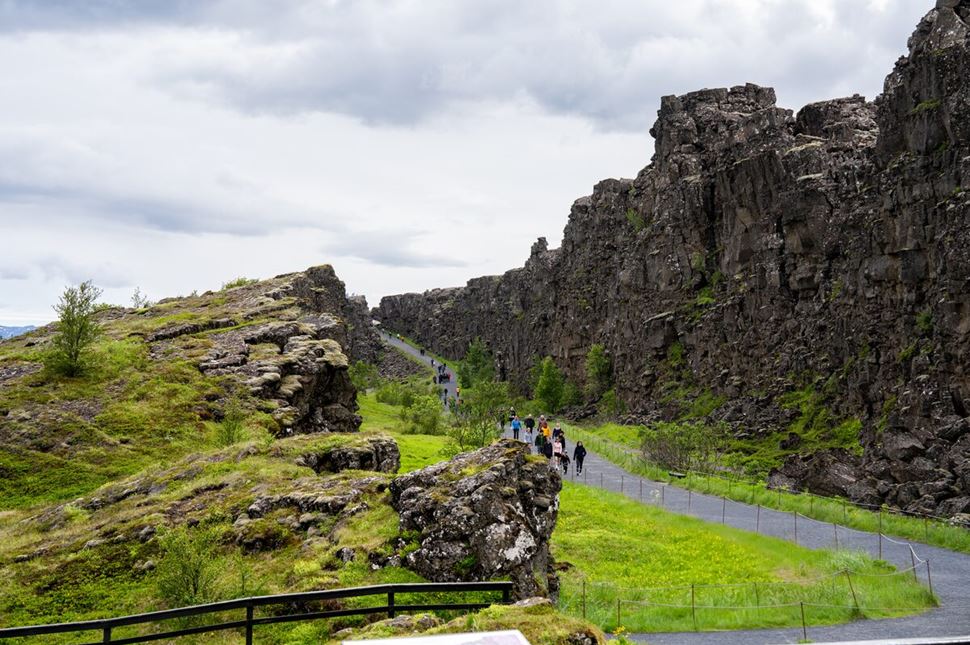
Tectonic rift of Thingvellir—first stop of the day. Source: Arctic Adventures.
Route: Reykjavík → Golden Circle → South Coast
Highlights: Þingvellir, Gullfoss, Geysir, Reynisfjara black beach, Skógar, Skógafoss, Seljalandsfoss, Sólheimajökull glacier.
After leaving Reykjavík, head north along the Ring Road before quickly turning off toward Þingvellir National Park—one of the iconic stops on the Golden Circle. From there, continue to the Geysir geothermal area, where erupting hot springs steal the show. Finish off the route at the powerful Gullfoss waterfall, a popular pick-up point for snowmobile tours.
Returning to the Ring Road, you’ll travel along the South Coast, home to grand waterfalls, charming villages, and the stunning black beach at Reynisfjara. As you enter the region, you’re greeted by Seljalandsfoss waterfall and its open cove. A short walk away is Gljúfrabúi cascade, hidden in a dramatic ravine. In Skógar, Skógafoss cascade plunges from the cliffs and crashes into the ground, a sight best viewed either from the base or a ridge above. Sólheimajökull glacier is just a short detour from the Ring Road. Why not explore it with an exciting guided hike?
As evening approaches, settle in for the night near the village of Vík or Skógar settlement. Relax at the Adventure Hotel Geirland, located in the heart of South Iceland. Nearby are Fjaðrárgljúfur Canyon and Skaftafell nature reserve. With 40 rooms, free parking, Wi-Fi, and a breakfast buffet, it's an ideal place to recharge.
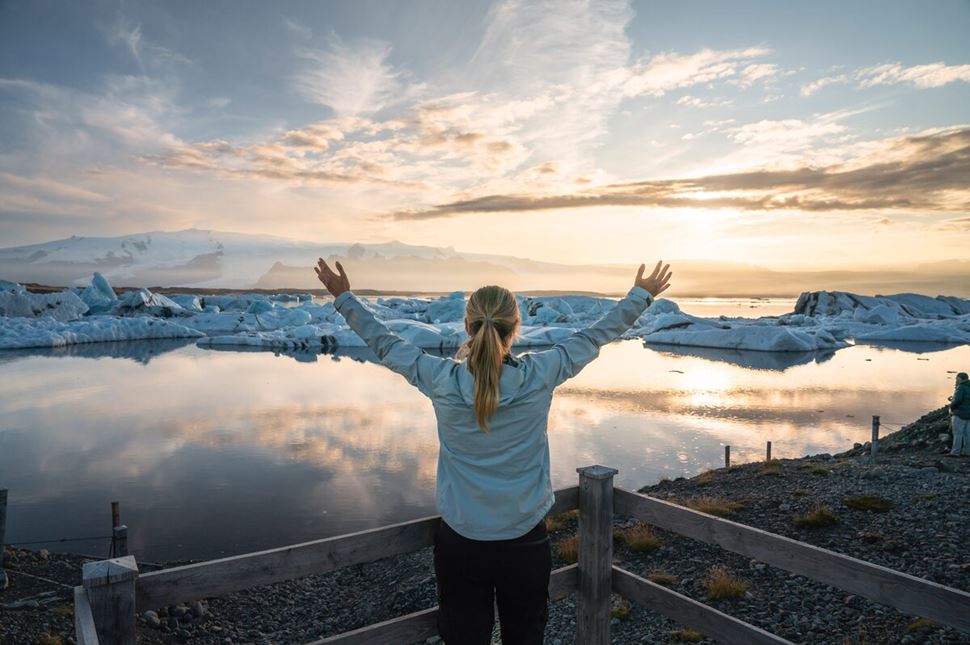
Reflective waters of a glacier lagoon on the South Coast. Image by Gunnar Gaukur.
Route: South Coast → Skaftafell
Highlights: Skaftafell area, Svartifoss waterfall, Jökulsárlón glacier lagoon, Diamond Beach, Vatnajökull glacier.
Energized and ready, you’ll start the day by heading to Skaftafell nature reserve. A quick hike in the area will lead you to one of Iceland's most incredible waterfalls, Svartifoss. Known as the Black Waterfall, its nickname stems from the hexagonal black basalt columns that surround the white, shimmering cascade. You also have another glacier hike opportunity at Skaftafell today—whether an easy one or more challenging, the choice is yours!
Depending on how much time you spend enjoying activities and sights, you could visit the stunning Jökulsárlón Glacier Lagoon today or leave that wonder for tomorrow. Our tip? Give yourself plenty of time to enjoy the majesty of the crazily shaped icebergs floating beneath Vatnajökull glacier. If you follow the coast toward the ocean, you’ll reach the black sand of Diamond Beach, known for its breathtaking contrasts.
As you journey through the scenic South Coast, consider staying at Adventure Hotel Hof. Nestled in Iceland's Öræfi region, it is an ideal stop for travelers exploring the South Coast and East Fjords. A strategic base for your adventures, you’re just a stone's throw from Hofskirkja church and a short drive to Vatnajökull National Park and Jokulsarlon Glacier Lagoon.
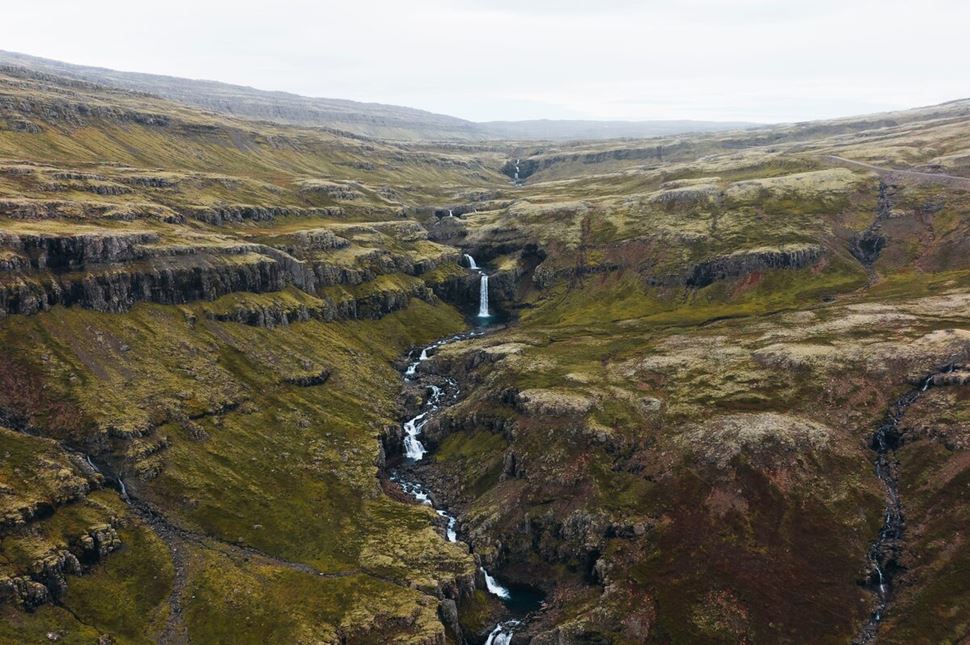
Cascades of Klifbrekkufossar waterfall in the East Fjords. Captured by Gunnar Gaukur.
Route: Skaftafell → Eastfjords
Highlights: Jökulsárlón (if not visited the previous day), Egilsstaðir, Seyðisfjörður, Reyðarfjörður, Eskifjörður.
Today is all about exploring the rocky coasts of the East Fjords. Start with Jökulsárlón if you didn’t see it yesterday, want one last mesmerizing view, or have booked an exciting activity, like kayaking. Then, head toward the east. Route 1 winds in and out along the shore, threading a line between the ocean and mountains. Though sharp fjords carve deeply into rugged, jagged cliffs, there are safe spots to stop and take in the incredible views.
You will be heading towards Egilsstaðir city, 187 km (116 mi) away from the Höfn settlement. The lack of attractions means you’ll be left to enjoy the shifting terrain and lush woods. Eventually, you’ll glimpse into the calm waters of Lake Lagarfljót, home to the fabled giant water worm and a sign that you have arrived at your destination.
Some people like to stay around Egilsstaðir for the night, but you can cross the mountains to stay at either Seyðisfjörður or Reyðarfjörður, fjords that are perfect destinations for hikes. For a more immersive night, drive south on Road 931 to the Wilderness Center in the Highland wilderness, which serves as both a time capsule and a place to stay.
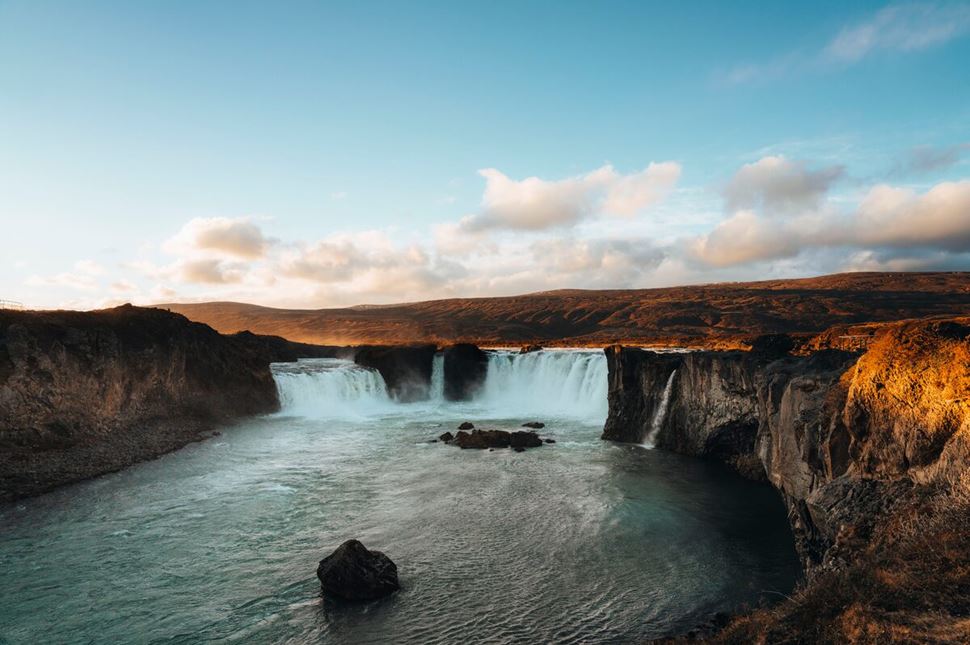
Curving fall of North Iceland’s Goðafoss waterfall. Photo by Arctic Adventures.
Route: Eastfjords → Lake Mývatn → Akureyri
Highlights: Dettifoss waterfall, Mývatn Nature Baths, Námafjall, Dimmuborgir, Goðafoss waterfall, Akureyri.
Heading north today, you’ll venture into the wilderness of Iceland's Arctic region. Starting with a slight detour to Dettifoss waterfall, you’ll witness a mighty torrent crashing through a rugged canyon. Not far from here is Lake Mývatn, a volcanic beauty turned birdwatching sanctuary. From the surreal Dimmuborgir lava fields to the bubbling mud pots and steaming vents at Námafjall, this area is packed with natural wonders.
As you continue on Route 1, you’ll pass Goðafoss waterfall, a crescent-shaped cascade often associated with Nordic gods due to its rich religious history and beauty. Driving along Eyjafjörður, Iceland’s longest fjord, will lead you to the charming city of Akureyri. Take some time to explore the northern capital and gawk at the towering Akureyri Church and its stained glass windows. From May to September, guided whale-watching expeditions go to the Arctic Ocean in search of marine life.
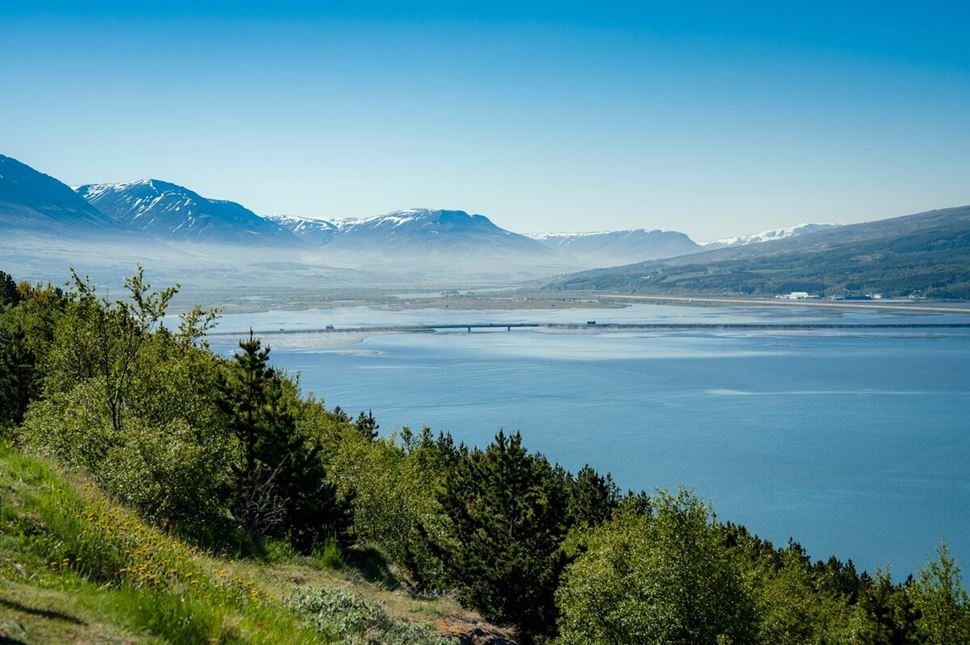
Mountains and waters around Akureyri in the North. Source: Gunnar Gaukur.
Route: Akureyri → Tröllaskagi Peninsula → West Iceland → Reykjavík
Today, you’ll be making your way back to modern civilization. It’s a long drive from the wilderness of the north to the open landscapes of West Iceland through the Trollaskagi peninsula. Rather than stopping at large landmarks, you'll be treated to the breathtaking mountain views that accompany you for most of the journey.
Eventually, you’ll reach Borgarnes—gateway city to the south. An hour's drive more and you’ll be back in Reykjavík. If you have time, explore the capital, try various dishes, or relax in your accommodations. Ensure that you return the rented car to a designated location to avoid incurring additional fees.
While you can drive the Ring Road in about five days, you have the flexibility to extend your trip with scenic detours. Iceland’s Ring Road itinerary of 7 days covers the main Route 1 areas, along with popular side trips to Snæfellsnes and the Silver Circle. These regions, part of West Iceland, serve as starting points for epic adventures or fulfilling conclusions to your Icelandic journey.
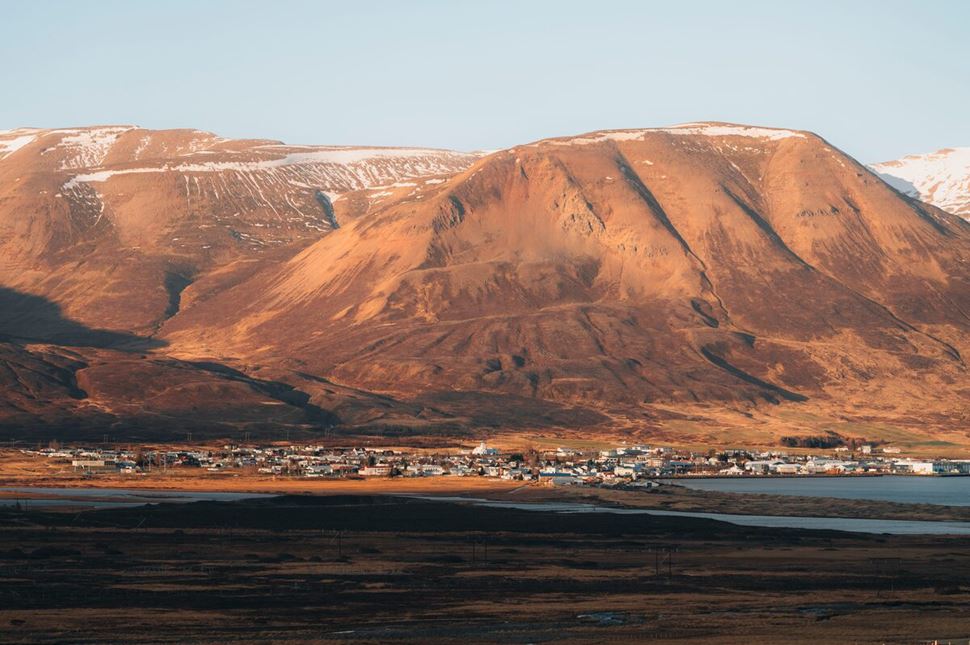
Dalvík village rests on the shores of the Tröllaskagi peninsula. Photo by Gunnar Gaukur.
Route: Akureyri → Tröllaskagi Peninsula → Siglufjörður → Skagafjörður
Highlights: Dalvík, Siglufjörður, Hofsós, Skagafjörður.
Instead of driving straight to Reykjavík, use the fifth day to explore the mountainous Tröllaskagi peninsula. Leaving Akureyri behind, kick off your day with the cozy Dalvík fishing village in the heart of Iceland’s ski territory. One tip: book yourself a whale-watching tour from the harbors of this settlement.
Next, continue on road 82 along the shoreline, passing through the Arctic. Stop to enjoy the wide blues on your right or the snowy mountains on your left. Eventually, the path will take you through the town of Ólafsfjörður and finally to Siglufjörður settlement at the bottom of a fjord.
From here, follow Road 76 as you descend into the heart of Skagafjörður fjord. Along the way, glance westward to catch views of Málmey and Þórðarhöfði islands, with glimpses of another distant fjord on the horizon. For now, continue south onto Road 75 and make your way to Sauðárkrókur—a peaceful town ideal for an overnight stay.
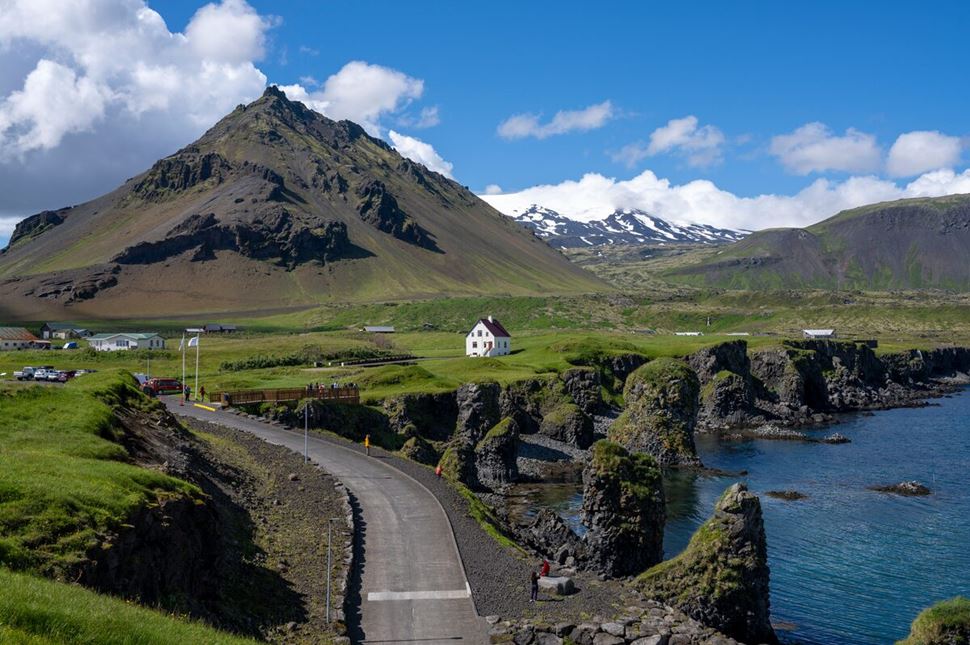
Mountains overlook the Arnarstapi settlement in Snæfellsnes. Source: Arctic Adventures.
Route: Skagafjörður → Snæfellsnes Peninsula
Highlights: Snæfellsjökull National Park, Kirkjufell Mountain, Arnarstapi village.
From Sauðárkrókur, head south on Road 75 until it joins the endless ribbon of Route 1. Follow it westward, then turn onto Road 60 when the sign appears. Keep going until a right-hand turn leads you onto Road 54, heading toward “Ólafsvík.” This is where the magic begins—you’ve entered the wild, wind-swept beauty of Snæfellsnes.
Your first stop: Kirkjufell, an arrowhead mountain that’s graced a thousand postcards. Near its base lies Grundarfjörður, a cozy seaside town with warm cafés and welcoming guesthouses. Continue on Route 574, where the road hugs the coast and leads you through the fishing towns of Ólafsvík and Hellissandur. For a good night’s rest, Hotel Hellissandur is a solid bet.
To the south, Snæfellsjökull National Park unfurls—a land of lava, mist, and myth. At its heart rises the glacier-crowned volcano, a landmark featured in world-renowned literary works. Around the geological wonder, trails wind through twisted lava fields and past crashing falls, tempting every adventurer’s soul.
But Snæfellsnes offers more than wilderness. The coastal village of Arnarstapi welcomes visitors with a lively bird population and crashing waves just offshore. In the ancient Hellnar settlement, time slows—order a coffee, breathe deep, and let the view of the Atlantic Ocean do the rest.
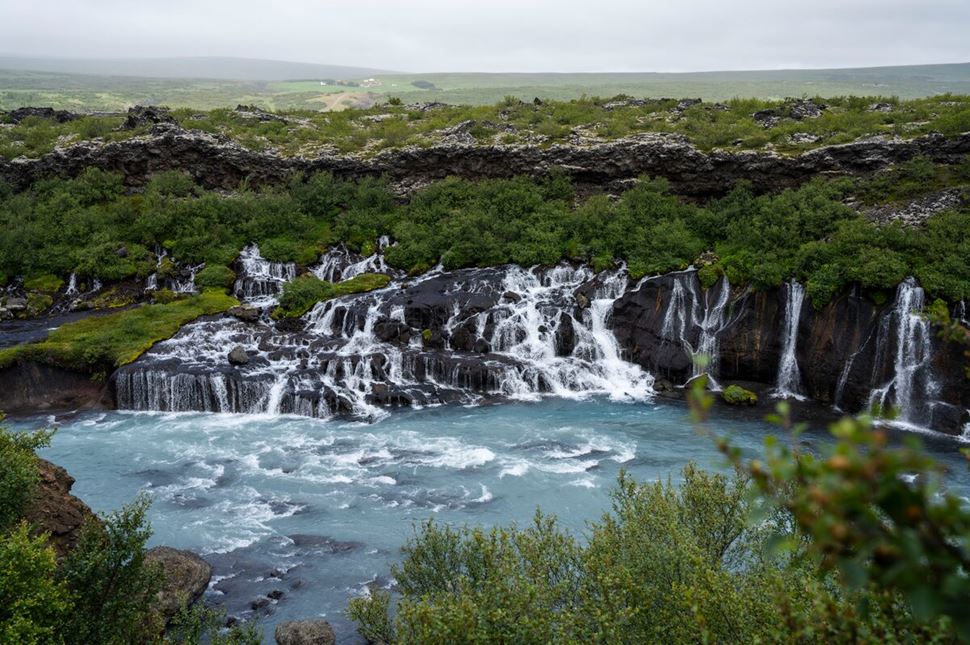
Multiple cascades of Hraunfossar waterfall. Photographed by Gunnar Gaukur.
Route: Snæfellsnes Peninsula → Silver Circle → Reykjavík
Highlights: Hraunfossar and Barnafoss waterfalls, Deildartunguhver hot spring, Reykholt, Víðgelmir lava cave.
Your final day leads you back toward Reykjavík, but not before one last adventure—through the mystical landscapes of the Silver Circle.
Start early, heading south on Road 54. Briefly join Route 1 through Borgarnes, then veer northeast on Road 50 to Deildartunguhver hot spring, where scalding water bursts from the earth in swirling steam. Continue on Road 518 to Reykholt, once home to Snorri Sturluson, the saga master of medieval Iceland. Just beyond are the twin waterfalls: Hraunfossar, with gentle streams weaving through lava, and Barnafoss, churning fiercely through narrow rock channels steeped in dark legends.
If time allows, explore Víðgelmir, one of Iceland’s largest lava caves, echoing beneath the surface. On the way, pass through Húsafell, a lush haven with scenic trails perfect for a short break. For an unforgettable adventure, consider the Into the Glacier tour—an otherworldly journey inside Langjökull’s icy core.
When it’s time to return, follow Route 1 south, diving beneath the fjord through the Hvalfjörður Tunnel. Soon enough, Reykjavík’s colorful streets will welcome you back. After a journey shaped by fire, ice, and story, you’ve earned your own perfect ending. Wander the vibrant city, savoring one last Icelandic meal, or simply watch the northern sky.
Want to stretch your Iceland adventure a little longer? Easy. Extend the Icelandic Ring Road itinerary to 10 days by adding a few extra gems along the way. Use one of those days to dive deeper into regions you’ve already visited, like Eastfjords, North Coast, or Snæfellsnes Peninsula. Save the final two days for the capital region and the fiery, otherworldly landscapes of the Reykjanes Peninsula.
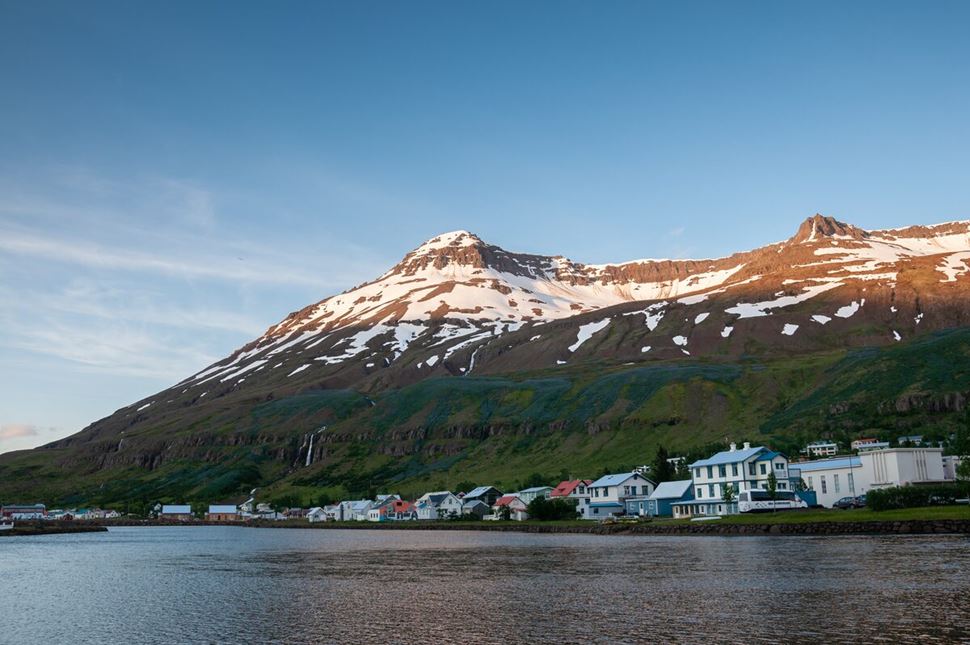
Egilsstadir with the Eastfjords mountain behind.
When: Consider adding this extra day before Day 4.
Highlights: More time to explore the dramatic fjords, quaint fishing villages, and hidden waterfalls.
Instead of rushing north, slow down and savor the quiet beauty around Egilsstaðir. Stretch your legs on the hiking trails that wind through the hills and forests near town, or circle the mysterious Lagarfljót lake. Then venture out to the remote coastal villages of Bakkagerði or Seyðisfjörður, where mountains meet the sea. In Bakkagerði, don’t miss Petra’s Stone Collection—a quirky display of minerals—and feel the creative spirit that hums through the village year-round.
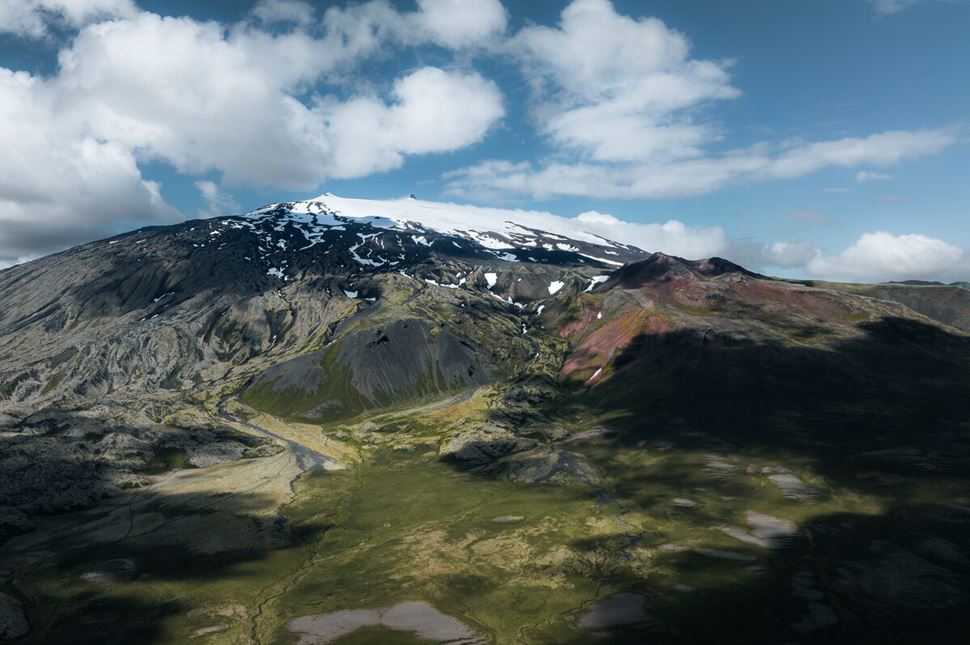
Snowy peak of Snæfellsjökull glacier in Snæfellsnes. Source: Arctic Adventures.
When: Consider adding this extra day before Day 7.
Highlights: Vatnshellir cave, additional hiking trails, and exploring more of the rugged coastline.
Stay an extra day to soak in the magic of Snæfellsnes National Park. Venture underground into Vatnshellir, an 8,000-year-old lava tube that winds 200 m (656 ft) through the earth, descending 35 m (114 ft) into a world of shadow and stone. Then, head to the Lóndrangar cliffs between May and August for birdwatching opportunities. You might even spot the iconic puffins living their birdly lives on the shores of the island.
Looking for bigger creatures? Watch for seals lounging along the golden sands of Ytri Tunga beach. End your day with a visit to the striking black church of Búðir, standing solitary against the wild landscape.
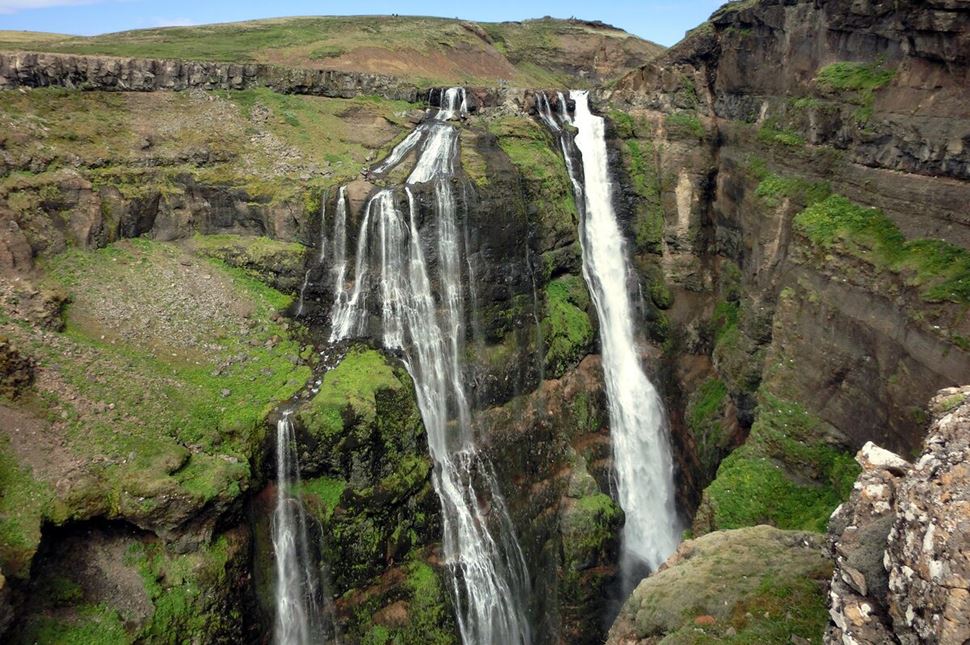
Glymur waterfall in the canyon of West Iceland.
After exploring the Silver Circle on Day 7, don’t rush back to Reykjavík just yet. First, make a quick stop in Borgarnes, the gateway between West Iceland and the capital region. Despite its small size, you’ll find a solid range of restaurants and accommodations here. However, the standout attraction is Landnámssetrið, a Settlement Center. The establishment brings to life the stories of Iceland’s first settlers through engaging exhibits and displays inspired by the sagas.
Follow Route 1 and detour onto Road 47, a scenic stretch where mountains rise on one side and the shimmering waters of Hvalfjörður Fjord stretch out on the other. This road leads you to the trailhead for one of Iceland’s hidden gems: Glymur Waterfall. At 198 m (650 ft), it’s the second-highest waterfall in the country, tucked deep in a green, narrow canyon. The 3 to 4-hour round-trip hike is at times challenging, but the payoff—a roaring cascade plunging into a misty gorge—is unforgettable.
After the hike, go along Road 47 until it reconnects with Route 1. Point your car south and cruise past the quiet village of Grundarhverfi. Before long, the city lights of Reykjavík will welcome you back. Whether you rest or wander the lively streets filled with cafés, galleries, and shops, it’s your moment to ease into the final stretch of the journey!
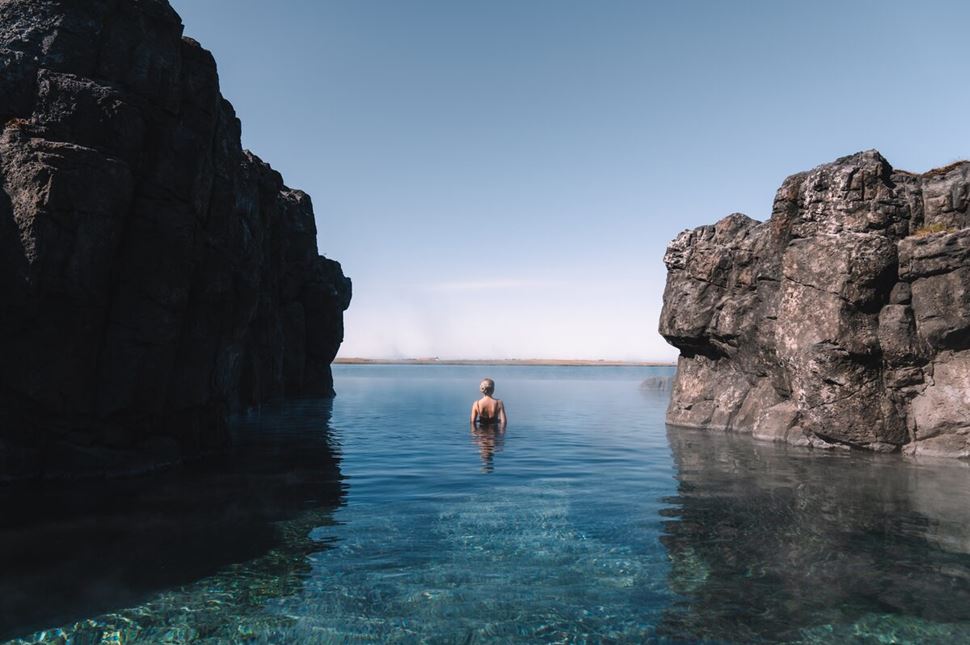
Steaming and crystal clear waters of Sky Lagoon.
Route: Reykjavík → Reykjanes Peninsula → Reykjavík
Highlights: Sky Lagoon, Krýsuvík geothermal area, Bridge between continents.
Get ready to explore the Reykjanes Peninsula, where the earth's raw power is on full display. Start your day with a relaxing soak in the Sky Lagoon, a stunning geothermal spa perched on the ocean’s edge. Or, if you prefer to end your day with a sunset dip, save it for later. Next, head south on Route 1, then turn onto Road 38 toward the quiet seaside town of Þorlákshöfn.
From there, follow Road 427, with a brief detour on Road 42, to reach the surreal geothermal fields of Seltún. Here, steam rises in thick clouds, and bubbling mud pools hiss and gurgle. The landscape is painted in shades of rust, sulfur, and smoke. Next, you can visit the site of the Sundhnúkur eruptions near Grindavík—when conditions and Icelandic authorities say it’s safe. The area is an ever-changing field of fresh lava flows that make the news worldwide. If there is an active eruption, you can even book a helicopter tour over active volcano and glowing lava rivers. Note: tours run only when the eruptions are stable and access is officially approved.
Before leaving the peninsula, visit the Bridge Between Continents near Road 44. Cross the small pathway, and you’ll go from the Eurasian to the North American tectonic plate—a symbolic crossing between worlds. After this, head to the far tip of the region, where the Reykjanes lighthouse stands watch over the sea. Nearby jagged Valahnúkamöl cliffs mark the land’s final edge.
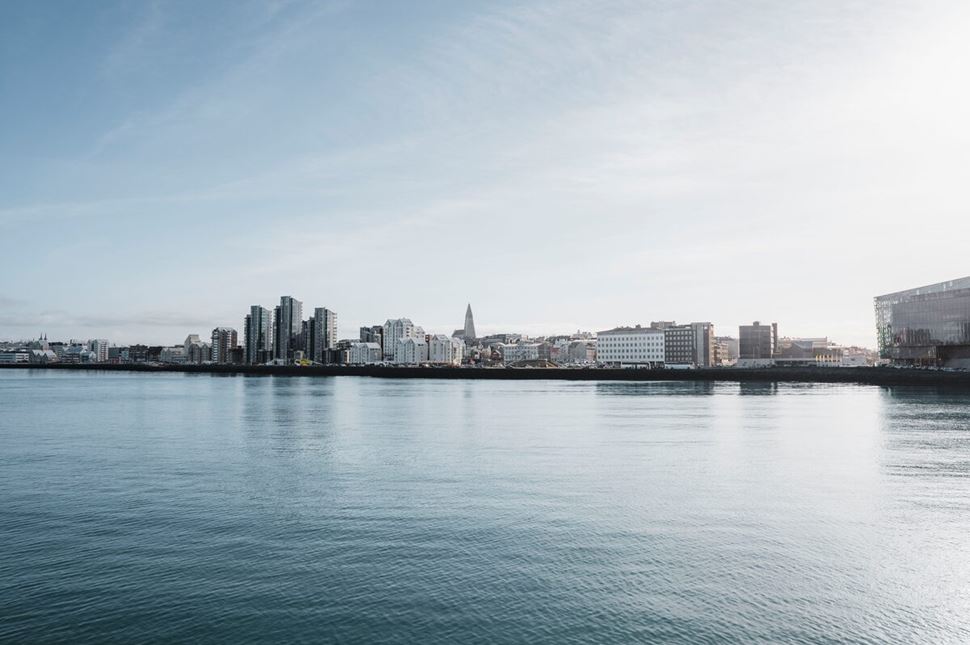
Reykjavik skyline from Faxaflói bay. Source: Gunnar Gaukur.
Route: Reykjavík → Keflavík International Airport
Highlights: Hallgrímskirkja, Harpa Concert Hall, Old Harbour, Laugavegur shopping street.
Our 10-day Iceland Ring Road itinerary ends in the tourism heart of Reykjavík. If you haven’t already, visit the grand Hallgrímskirkja church, whose hexagonal exterior is inspired by the basalt columns of Svartifoss waterfall. Wander over to the gleaming glassed Harpa concert hall and stroll around the Old Harbour area. For souvenirs, head to Laugavegur Street, lined with local shops. Reykjavík seamlessly blends modern city life with deep-rooted tradition, making it the perfect final note to your unforgettable journey.
A well-planned Ring Road in Iceland itinerary is just part of the plan—now comes the execution. For most of your adventure, you’ll be behind the wheel of a car, navigating Route 1 and facing all the challenges the island will throw at you. Luckily, if you take the time to prepare, read up on essential information, and brace yourself for the many possibilities, you’ll travel from one attraction to another safely and efficiently.
Driving the full 1,322 km (821 mi) of Iceland’s Ring Road in a single push takes around 17 to 20 hours, with only the briefest of stops. It’s a demanding itinerary that leaves little time for detours, sightseeing, or extended breaks. In winter, shorter daylight hours and weather conditions can make travel slower and require extra caution.
Most travelers tend to take the circular highway in a gentler rhythm, breaking the journey into multiple days. A 4–5 day plan is a good starting point: it allows time to see the main attractions on the South Coast, Golden Circle, and more. With 6–7 days, horizons expand to explore Snaefellsnes Peninsula or the Silver Circle. But give it 10 days or more, and the journey transforms: driving becomes a thread that gently ties together longer hikes, extra activities, and restful mornings and evenings.
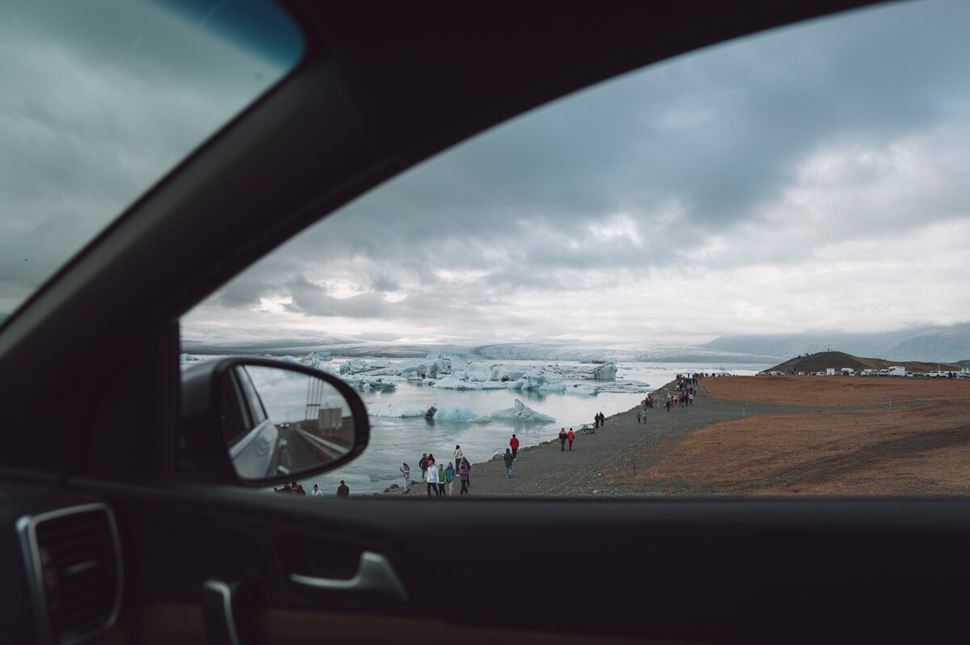
Glacier lagoon view from the side window of a car in 2024. Photo by Gunnar Gaukur.
Yes, a regular 2WD car is sufficient for Route 1 in summer, as the highway is paved and well-kept throughout the year. Even the side roads leading to treasures like Snaefellsnes, the Silver Circle, and the Golden Circle boast pavement nearly as smooth as the famed Ring Road itself. Yet, the rugged F-roads remain off-limits to these vehicles—territory reserved for sturdy 4x4s.
When winter’s grip tightens, the 4WD emerges as the wiser choice. Its extra power and traction become lifelines, slicing through snowdrifts and clutching icy stretches where lesser wheels might falter, transforming a treacherous challenge into a confident journey.
The direction you choose to travel Iceland’s Ring Road depends on what you seek. Most travelers head counterclockwise, beginning with the famed Golden Circle and the dramatic landscapes of the South Coast. This route aligns with most guidebooks and itineraries, making it a natural choice, especially for first-time visitors.
But nothing is stopping you from going clockwise. Starting in the west and moving northward begins with a quieter start with fewer crowds and a slower build toward Iceland’s iconic southern wonders. In the end, it’s not about right or wrong—it’s about the rhythm that matches your travel style.
In winter, Iceland’s Route 1 remains generally safe for travel in a 4WD vehicle. The Ring Road benefits from regular maintenance and cleared paths free of snow. Yet, this is no time for letting your guard down. Ice still clings to the surface, turning stretches of road into slick traps. Fog may roll in without warning, particularly in mountainous areas.
Between November and March, storms sweep across the land, bringing snow, wind, and whiteout conditions. These factors are more impactful in the north, so if you’re not ready for these wintry trials, focus on the South Coast and Golden Circle. The rest can wait for summer, when the roads become less challenging and the land opens up under a gentler sky.
The key to navigating Iceland’s roads is to drive like a local: with care, calm, and readiness for the unexpected. Follow the rules of the road—speed limits are 50 km/h (31 mph) in towns, 90 km/h (56 mph) in rural stretches, or as otherwise posted. Let caution be your compass.
Dress wisely, not heavily. In summer, bulky layers can hinder your comfort behind the wheel. Instead, embrace the island with a practical layering system of base, middle, and outer. Comfortable hiking shoes are a must, and sunglasses will protect your eyes from the sun's glare.
Resist the urge to pack your car to the brim. Travel light, but intentionally. Make an Icelandic road trip packing list based on your plans—whether you’re chasing waterfalls or camping under the midnight sun. Bring a tent if you’ll be staying in towns with designated campsites, and don’t forget the essentials such as a first-aid kit and basic toiletries.
Traveling the Ring Road in Iceland doesn’t have to cost a fortune. You can do it on a relatively small trip budget if you do some careful planning and extreme prioritization:
Buy airline tickets to Iceland for off-season months. September to October and March to May are the shoulder seasons, times when tourism slows down. With lower demand, prices in Iceland fall for tours, accommodations, and restaurants.
Book your accommodations months in advance. An overnight stay is the most expensive part of traveling in the Scandinavian island, but early birds tend to get a better deal. Instead of hotels, look for Airbnb.com openings or reserve spots in hostels, where you can mingle with fellow travelers.
Focus on sightseeing, not activities. Whale-watching and glacier hikes, while exciting, are best left aside to save money for food, souvenirs, and fuel. Most of the major attractions, like Thingvellir and Goðafoss, can be enjoyed for free. If you want to dip into a hot spring, Djúpavogskörin and Seljavallalaug geothermal pools are free of charge.
Yes, you can travel around Iceland via the circular Ring Road or Route 1. The 1,322 km (821 mi) long roadway goes around the Highlands and connects back to Reykjavík. Through branching roads, you can reach Snaefellsnes peninsula, the Westfjords, the Reykjanes peninsula, and the Highlands.
It takes about 10 days to drive through all major regions of Iceland. In 5 days, travelers can complete the Ring Road, covering the South Coast, East Fjords, North Iceland, and West Iceland. Add one extra day each for the Golden Circle, Westfjords, Snæfellsnes Peninsula, Reykjanes Peninsula, and the Highlands.
Yes, Iceland’s Ring Road is worth it for its diverse landscapes and major attractions. With a few detours, you’ll see southern waterfalls, eastern fjords, northern wilderness, and western open spaces. Route 1 is well-maintained and open year-round, making it ideal for both summer and winter trips.
Iceland’s Ring Road is around 1,322 km (821 mi) long and loops around the whole island. The roadway passes through the coastal regions, excluding the Snæfellsnes peninsula and the Westfjords. However, according to The Reykjavík Grapevine, Route 1 will become 12 km (7.5 mi) shorter before 2026.
Driving Iceland’s Ring Road non-stop takes about 17–20 hours in good summer conditions. However, travelers typically spread the trip over 5 days to allow time for sightseeing and activities. Most opt for a 7-day itinerary that includes the Golden Circle and the Snæfellsnes Peninsula.
A 4x4 isn’t required to drive Iceland’s Ring Road—it’s paved and well-maintained year-round. However, in winter or inclement weather, a 4WD offers better traction and safety. Additionally, 2WD vehicles are restricted to main roads and aren’t permitted on gravel F-roads.
Yes, you can drive the Ring Road in winter, as the roadway is paved and maintained regularly throughout every season. A 4x4 vehicle is recommended for better traction. Please note that some sections may be closed due to weather or repairs, so be sure to check the Icelandic Road Administration website before traveling.
Most travelers drive the Ring Road counterclockwise, starting with the popular South Coast and Golden Circle. Others go clockwise, beginning with West Iceland and Snæfellsnes or the Silver Circle. Either direction covers the same regions—it’s just a matter of preference.
Summer is ideal for driving Iceland’s Ring Road—long daylight from the midnight sun and milder weather. Roads are clear of snow and ice; fog may occur in the mountains. May and September are good alternatives, with September being the start of the Northern Lights season.
Yes, gas stations are available along the Ring Road, particularly in tourist-heavy areas such as the South Coast. Major chains with self-service pumps cover most of the route. In remote regions like the North Coast and East Fjords, stations are mainly located in towns.
Yes, you can drive the Icelandic Ring Road in 7 days, a time table most travelers choose. You’ll be able to balance sightseeing and driving every day of the journey, and not miss out on remarkable landmarks. Additionally, you can include the Silver Circle and the Snæfellsnes peninsula detours.
The Golden Circle is best suited for a single-day trip, while the Ring Road is ideal for a week-long adventure. The Ring Road circles Iceland, covering the South Coast, East Fjords, North Coast, and West Iceland. The Golden Circle highlights three nearby sites: Þingvellir National Park, Geysir, and Gullfoss Waterfall.
Yes, you can complete the Ring Road in 6 days, but sightseeing will be limited. Spend 4 days covering the South and North coasts, and 1 day each in the Eastfjords and West Iceland. Adding an extra day for the Snæfellsnes Peninsula is recommended if possible.
Yes, 8 days is enough to complete Iceland’s Ring Road. The extra time allows for activities like whale-watching in the north or glacier hiking in the south. If finished early, you can explore detours like the Golden or Silver Circles.
Yes, driving the Ring Road in Iceland is safe. However, the weather changes rapidly and unpredictably. One moment it might be sunshine and bright, the other—thunder and cloudy. Always check the weather forecast and road conditions before setting out.
The cost to travel Iceland’s Ring road ranges between 152,650 ISK (~€1,057/$1,145) and 420,500 ISK (~€2,912 /$3,155) for a week. A basic KIA Rio 2WD costs around 37,176 ISK (~€260 / $307) (Blue Car Rental). Accommodation prices vary, with hostels being the most affordable, while hotels are the most expensive. (Prices updated: 2025)